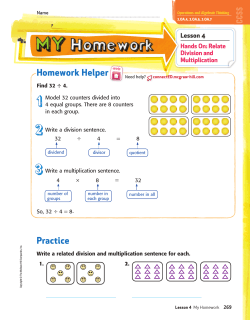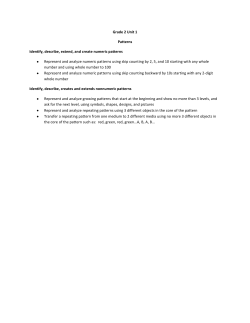
Standard: MACC.3.OA.4.9 Depth of Knowledge Identify arithmetic
Standard: MACC.3.OA.4.9 Depth of Knowledge Identify arithmetic patterns (including patterns in the addition Level 3: Strategic Thinking table or multiplication table), and explain them using properties of & Complex Reasoning operations. For example, observe that 4 times a number is always even, and explain why 4 times a number can be decomposed into two equal addends. Content Limits/Clarifications: Sample Test Item This standard calls for students to examine arithmetic Ralph loves to look for patterns in numbers. patterns involving both addition and multiplication. One day, he was looking at a multiplication Arithmetic patterns are patterns that change by the same chart and noticed that the product of 5 times rate, such as adding the same number. For example, the series 2, 4, 6, 8, 10 is an arithmetic pattern that increases an odd number always has 5 ones (5, 15, 25, 35, etc.) and the product of 5 times an even by 2 between each term. This standard also mentions identifying patterns related to the properties of number always has zero ones (10, 20, 30, 40, operations. Using a multiplication table, highlight a row etc.). He made some arrays to help him figure of numbers and ask students what they notice about the out the pattern. highlighted numbers. Explain a pattern using properties of operations. When (commutative property) one changes the order of the factors they will still gets the same product, example 6 x 5 = 30 and 5 x 6 = 30. Teacher: What pattern do you notice when 2, 4, 6, 8, or 10 are multiplied by any number (even or odd)? Student: The product will always be an even number. Teacher: Why? In an addition table ask what patterns they notice? Explain why the pattern works this way? Students need ample opportunities to observe and identify important numerical patterns related to operations. They should build on their previous experiences with properties related to addition and subtraction. Students investigate addition and multiplication tables in search of patterns and explain why these patterns make sense mathematically. Students also investigate a hundreds chart in search of addition and subtraction patterns. They record and organize all the different possible sums of a number and explain why the pattern makes sense. Ideas to Support MACC.3.OA.4.9 o o o The use of manipulatives is useful for practice with this skill. Such activities allow students to create their own patterns and then express their creations with a numeric sentence. For example, students can highlight all of the even numbers on a 100s chart. They can then express the pattern as "plus 2" to go from one highlighted number to the next. 2 + 2 = 4, and 4 + 2 = 6, etc. Similarly, students can highlight all of the multiples of 10, and express these as a "plus 10" rule. They could show that 10 + 10 = 20, and 20 + 10 = 30, and all extensions of these equations will correspond with the highlighted numbers on the 100s chart. Using a multiplication table, students can look for all of the occurrences of a given number, say 24, and then express 24 as multiplication expressions that are all equivalent. 24 = 6 x 4 = 4 x 6 = 8 x 3 = 3 x 8. Teachers need to guide students’ interpretation of patterns they encounter into numeric sentences. Explain the pattern that Ralph found. On Monday morning the baker baked 4 full trays of cookies to sell in his shop. Each tray had the same number of cookies on it. Here is what the trays looked like on Monday evening. a. How many cookies did the baker sell on Monday? Show how to use multiplication equations and other operations, if needed, to show how you solved the problem. Refer to the trays of cookies in your explanation. b. Use words or equations to explain how you know your total is correct. Connections: SMPs to be Emphasized MP1- Make sense of problems and persevere in solving them. MP2- Reason abstractly and quantitatively. MP3- Construct viable arguments and critique the reasoning of others. MP6- Attend to precision. MP7- Look for and make use of structure. Critical Area Critical Area #1: Developing understanding of multiplication and division and strategies for multiplication and division within 100. 3rd Grade Related Standards: MACC.3.OA.4.8 Foundational Skills for 4th Grade: Use the four operations with whole numbers to solve problems. FCAT 2.0 Connections: Related NGSSS Standard(s) MA.3.A.4.1- Create, analyze, and represent patterns and relationships using words, variables, tables, and graphs. FCAT 2.0 Test Item Specification Benchmark Clarification: Students may extend numeric or graphic patterns beyond the next step, or find one or more missing elements in a numeric or graphic pattern. Students will identify the rule for a pattern or the relationship between numbers. Content Limits: Common Misconceptions: None listed. Items may use numeric patterns, graphic patterns, function tables, or graphs (bar graphs, pictographs, or line plots only). Numeric patterns should be shown with three or more elements. Graphic patterns should be shown with three or more examples of the pattern repeated. Students should not be asked to extend the pattern more than three steps beyond what is given or to provide more than three missing elements. Items will not include extending the pattern on a bar graph or pictograph. Rules for numeric patterns and relationships shown in function tables must include only one operation limited to addition, subtraction, or multiplication. Patterns or relationships involving multiplication are limited to the multiplication facts of 0 X 0 through 9 X 9. Function rules or relationships may be described using words, tables, graphs, or expressions using variables or geometric shapes (e.g., n, , ∆ ); however, the intent of the benchmark is not to assess solving equations.
© Copyright 2025





















